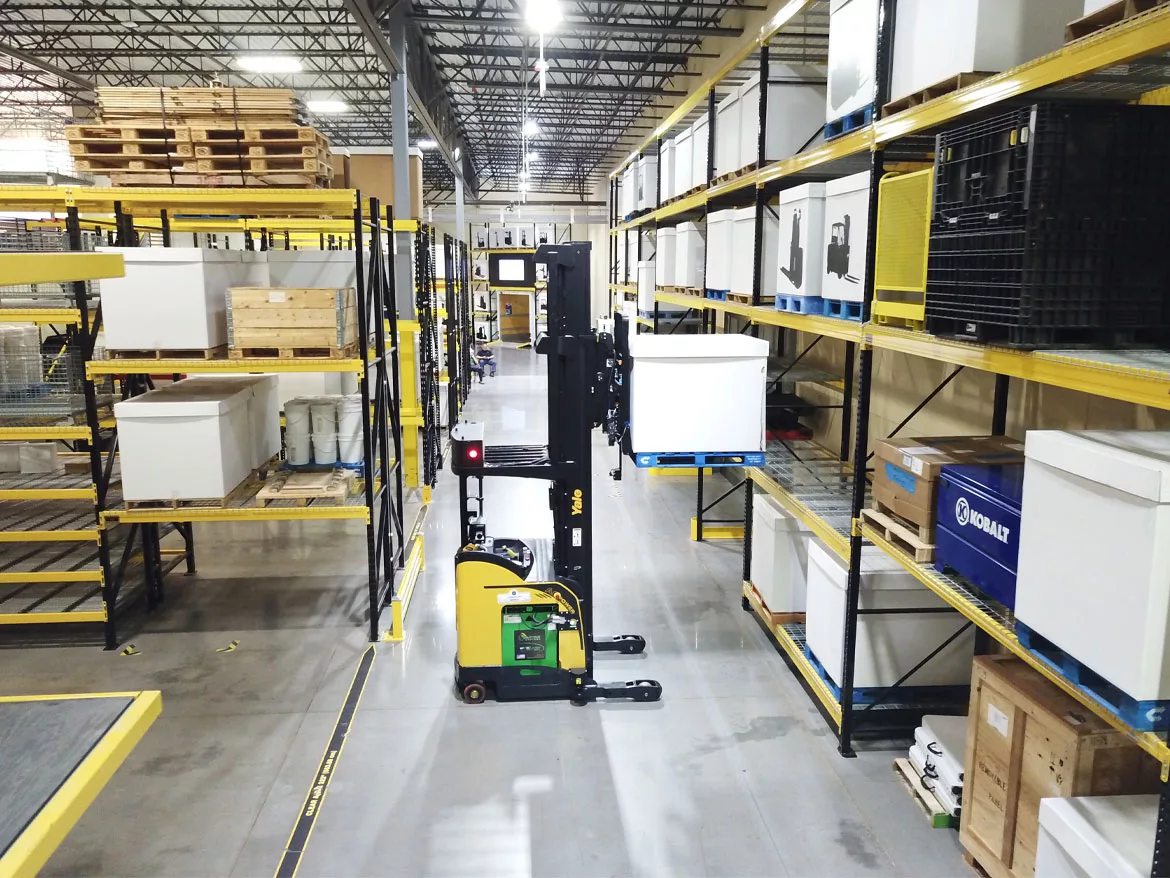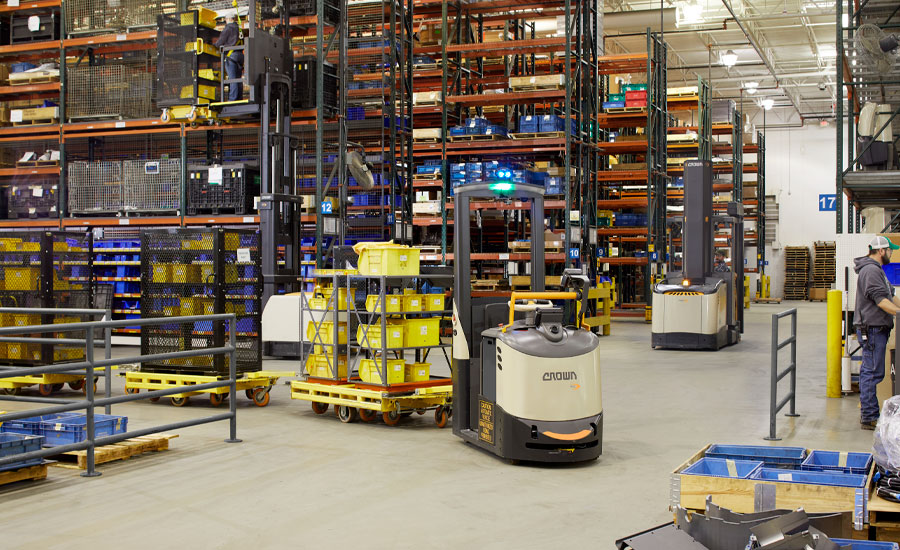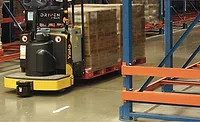Distribution
Automated guided vehicles optimize supply chain distribution
Advanced AGV sensors put vehicles on programmable path

According to the Bureau of Labor Statistics, warehouse labor turnover has risen to a new annual high of nearly 60%. Coupled with a severe labor shortage and the difficulty in hiring, training and retaining qualified workers, warehouse personnel carefully are evaluating how they utilize labor. Therefore, more operations managers are allocating workers for responsibilities that make the most productive use of their time while considering alternatives for lower-value, repetitive tasks.
Enter computer-controlled, wheel-based automated guided vehicles (AGVs) designed to run on the warehouse floor and handle repetitive tasks without the need for a driver.
Against this backdrop, improving employee satisfaction and retention can help lower operating costs in busy beverage warehouses, says Mark Koffarnus, director of major accounts for Yale Materials Handling Corp., Greenville, N.C.

Image courtesy of Crown Equipment
“Academic research shows that organizations augmented by automation technologies are 33% more likely to be ‘human friendly’ workplaces, in which employees are 31% more productive,” Koffarnus says. “That’s because robotics can relieve workers of the monotony of repetitive tasks that are abundant in supply chain environments, and instead focus on more rewarding, higher responsibility work.”
Jim Gaskell, director of global technology business development for Crown Equipment, points out that today’s AGVs are equipped with new advanced, lower cost sensors and other technical advancements.
“For instance, natural features navigation, where LiDAR scanners and cameras are used to help navigate a programmable path, has become a standard feature in most AGVs,” he says.
The New Bremen, Ohio-based company also is noticing that a growing number of beverage warehouses are taking a more strategic approach to considering and introducing AGVs. For instance, they are using data analytics to better understand which applications can be automated and assessing whether or not processes need to be changed or modified to ensure that the integration of the technology is a success, Gaskell explains.
“We’ve seen a number of innovations when it comes to AGVs,” Gaskell says. “Sensors have become more advanced and durable. We are starting to see an integration of automation systems and telematics systems. Natural features navigation are increasing operational safety. Better sensors are enabling today’s more advanced AGVs to see further and travel faster, up to one third faster than their predecessors.”
Distributed growth, expanding operations
While there’s a myriad of “bells and whistles” in cars when it comes to backup light cameras, navigational computers and assistance with parallel parking, the type of AGVs differ between traditional AGVs, which require guidance infrastructure to be installed while mobile robots do not share this requirement, according to Yale’s Koffarnus.
“[Mobile AGVs] use existing structural features like walls, columns and racks,” he explains. “They require a ‘walk’ of the facility to create an internal map to reference against what they see in real-time to self-locate and navigate.
“While not every situation is right for robotic lift trucks (RLTs), the technology has advanced to accommodate a range of horizontal transportation and vertical storage tasks in many environments,” he continues. “RLTs are especially well-suited to handle repetitive tasks and long runs, a valuable characteristic warehouses can use in strategies to help curb operator turnover.”

Image courtesy of Electtric80
For added flexibility, Crown’s Gaskell notes that many of today’s AGVs are equipped with dual mode technology that enables automated and manual operation. That flexibility and ability to switch between manual and automated operations can better accommodate dynamic changes in the production plan, he adds.
“Typical tasks that may be appropriate for automation are those that are similar to the tasks AGVs handle in manufacturing — consistent, repetitive, horizontal travel along the same route, particularly when product must move longer distances. In some instances, AGVs may be a lower-cost alternative to fixed conveyor systems, providing more flexibility and mobility and delivering an accelerated ROI.”
For warehouses interested in taking an incremental approach to automation and AGVs, Gaskell suggests that dual mode automation provides the perfect solution because there’s no additional supporting systems or infrastructure. Within dual mode vehicle deployment, operators are applying two approaches: bolt-on and integrated.
“The ‘bolt-on’ approach, which is often taken by technology integrators leveraging a forklift OEM’s manually operated chassis for development, begins with a manually operated lift truck and adds components to enable it to operate autonomously,” Gaskell explains. “The integrated approach, as taken by Crown, leverages the knowledge and experience acquired through building and deploying manually operated vehicles to design a new, readily scalable vehicle that includes fully integrated features that enable autonomous operation while retaining best-in-class attributes associated with manual operation ― essentially producing the best of both worlds.
“…Today’s dual mode AGVs enable existing workforce to be more productive,” he continues. “One employee can often manage multiple dual mode vehicles, stepping in only when manual operation is needed. In addition, a dual mode vehicle doesn’t require the specialized staff that may be required with a fully automated solution.”
Although a facility warehouse management system (WMS) is not a requirement when interfacing robotics software, WMS integration along with telematics to transmit computerized data can help manage workflow and ensure a more seamless operation, Yale’s Koffarnus notes.
He also suggests enlisting IT help early in the automation process. “[T]his helps determine requirements or can reveal any potential capacity issues that could make deferring WMS integration to a later phase a more attractive approach,” Koffarnus says.
Yale offers several different AGV robotics — a reach truck, an end rider, a tow tractor and a counterbalanced stacker — that can pick up, transport, drop off pallets and move carts to help companies reduce labor costs and optimize workflows, it says.
“The robotic reach truck, a 2020 Edison Award winner, autonomously deposits and retrieves loads in single and double-deep storage locations up to 30 feet high,” Koffarnus says. “It can handle basic point-to-point transportation tasks without requiring such a software integration, enabling operations to get robotics up and running quickly and more simply.”
The Yale robotic reach truck can serve single and double-deep pallet storage and offers a 3,500 pound capacity rating, ideal for distribution centers challenged with inventory growth. With an 8,000-pound capacity, the robotic end rider relieves operators of time-consuming point-to-point travel, automating the transportation of one to four pallets at a time over long, horizontal paths. The counterbalanced stacker can productively stack and unstack loads and/or deposit or remove pallets from second or third level storage with an ease that a forklift or employees can’t accomplish, he adds.
Meanwhile, Crown Equipment continues to expand the capabilities of its dual mode AGV technology so that it can meet the fluid needs of warehouse and distribution center environments.
For instance, the DualMode R 1000 reach truck offers users higher lift and lower speeds (160 feet per minute (fpm)/240 fpm) in manual and automated modes, making the AGV especially ideal for warehouses and distribution centers that have aisles dedicated to pallet put-aways and retrieval, Gaskell says.
With a capacity ranging from 6,600 to 11,000 pounds, the scalable and flexible Crown DualMode T 1000 tow tractor can travel at speeds as fast as 5.3 miles per hour. It can be used to pull carts and transport material between programmed points in a facility, with material being loaded and unloaded at destinations along the way, the company says.
Chalfont, Pa.-based JBT Corp. offers forkover AGVs designed to make the handling of open-bottom containers and skids simple. They also are able to make tighter turns and have greater maneuverability in narrow aisles compared to other AGV styles, the company’s website states. These AGVs can handle variable lift heights as tall as 20 feet and have an electric/hydraulic lift capacity of as much as 3,300 pounds. “With the ability to interface with conveyors, racking and stands, our forkover AGVs perform typical forklift operations more efficiently,” the website says.
Investing in automation, safety
Within a beverage warehouse, safety and the ability of an AGV robotized system to eliminate the risks associated with man-machine interaction is important. Emilia, Italy-based Elettric80 launched “SmartDect,” a wearable device worn by operators that increases the reliability of Industry 4.0 and sets a high safety standard inside warehouses.
Based on Ultra-Wide Band technology (UWB), the patented collision avoidance system enables the AGV to interact with special devices/tags worn by the operators, increasing the safety level of the entire system. The AGV also is fitted with antennas that communicate in real-time to detect the tags, tracking their position, speed and direction of movement. If the AGV detects operators and other vehicles in the surrounding area, it will slow down to a stop or continue on its path, if all is clear, the company said in a statement.
Along with safety, productivity continues to be a top driver of why AGVs are being deployed. Adopting automation and the flexibility and efficiency of AGVs needn’t come at a high price, experts advise.
“The technology allows companies to rethink the deployment of their workforce. It can enable them to focus employees on higher value tasks while repetitive tasks are completed through automation,” Crown’s Gaskell says.
Yale’s Koffarnus adds: “Seasoned managers might be inclined to assume that such significant efficiency gains must come at a steep price, but the truth is that robotic lift trucks actually help lower operating costs. While investing in automation can seem like a large expense upfront, a combination of labor, maintenance and equipment savings means that robotic lift trucks can cut operating expenses by up to 70% — making them a very sound investment.
“…When four Yale robotic counterbalanced stacker trucks are used [instead of three full-time operators on two shifts, five days a week], the distributor sees full payback in just two years. After breaking even on their investment, the distributor saves $246,000 per year in hourly labor costs, or nearly a half million dollars in two years.”
According to Research and Markets, Dublin, Ireland, the global warehouse vehicle market is anticipated to grow at a compound annual growth rate (CAGR) of more than 7% through 2026. Increasing demand from the automotive industry also is anticipated to drive growth.
“Based on the type, the market has been segmented into lift truck, narrow aisle trucks, pallet trucks and others,” it said in a statement. “Owing to the high performance, low operational cost and inexpensive maintenance, the lift truck vehicle type acquired the dominant share in 2020 and is anticipated to continue its dominance in the forecast period.”
Looking for a reprint of this article?
From high-res PDFs to custom plaques, order your copy today!





